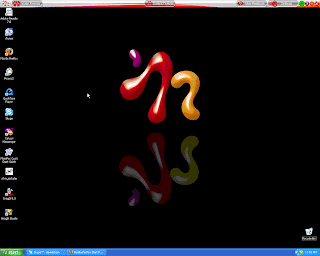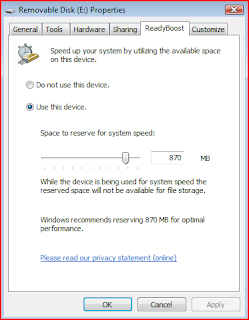
Well,A software called mojopac can do just that...........
The quest for knowledge cannot be quenched. Sriram answers your questions.


Eye-Fi Inc. today unveiled the Eye-Fi Card – the world’s first wireless SD memory card for digital cameras. It uses home Wi-Fi networks to create a convenient way for users to send photographs directly from digicams to computers and online photo and social networking sites.
All you need to do is simply turn on your digital camera and your pictures are wirelessly uploaded. The Eye-Fi Card works with existing and new SD-compatible digital cameras, and stores photos just like a conventional SD memory card.
During the simple setup process, users can select from among 17 popular online photo-sharing, printing, social networking, or blogging sites to publish and share their photographs, and select where on their PC or Mac they want to archive their images.
Once the setup is complete, users can focus on taking pictures and sharing memories – and not on the process of uploading photos from the camera. Eye-Fi’s free upload service allows users to transfer an unlimited number of photos. It handles full-resolution JPEG pictures and intelligently resizes images if required by the selected destination.
The 2GB wireless SD memory card is available now at major online retailers including Amazon.com for $99.99 (Rs 3,940).






Amazing news from Intel,I think our computers are going to be a lot faster in some time.
Read on and find out.
Intel has begun the transition for its processors from 45 nm to 32 nm chips. The objective is to reduce the size of the devices and the energy consumption. The company will give details about this change during a series of technical conferences on electronic devices in San Francisco, which are scheduled for December 15.
The new “Westmere” processors will be based on the Nehalem microarchitecture (Core i7) and the engineers will reveal how they are looking for new ways of reducing circuit power leakages when transistors are not working. Intel also plans to show its new SRAM memories (static RAM) that contain more than 1.9 billion transistors and a 3.8 GHz clock speed.
According to eWEEK, IBM and several of its partners (like AMD or Toshiba), will also reveal some advances in miniaturization of electronic components and a paper about their efforts to produce a 22-nm SRAM (static RAM) memory cell. On the other hand, Taiwan Semiconductor will present its plans to manufacture 32-nm processors
Intel Labs’s researchers have achieved good results in the field of silicon photonics. The company has now a record breaking silicon-based “Avalanche Photodetector” with a gain-bandwidth product of 340GHz. Silicon photonics is a new technology that uses standard silicon to send and receive optical information among computers and other electronic devices.
What a disk defragmenter does is increase the speed in which you can access information. Whenever your computer processes information it needs to jump from place to place and this takes time. Defragging your system allows your computer to stream information through one path. This will speed up laptop computers ability to access and run different programs.
Eliminate as many unnecessary startup programs as possible. Anytime you install a new program it will try to automatically start itself every time you power your computer on. This will dramatically slow down the speed your computer can start up or shut down. These programs also eat up valuable RAM which causes the computer to be very sluggish. Eliminate all but the necessary programs and feel the incredible difference in your laptop processor speed.
Clean up registry congestion. This is without question the most important step you can take to speed up your system. As we download new or remove old programs our registries get congested with useless and redundant files. This clogs everything up and leaves you asking why is my computer slow? Getting rid of those unnecessary files will not only speed up your computer but prevent it from crashing in the future.
These will surely get you going!
I was just surfing the net,when i came accross Toshiba's new 512GB solid state drive.For those who don't know about SSD,Here's a simple guide for you.
A solid-state drive (SSD) is a data storage device that uses solid-state memory to store persistent data. A SSD emulates a hard disk drive interface, thus easily replacing it in most applications. An SSD using SRAM or DRAM (instead of flash memory) is often called a RAM-drive.
The original usage of the term solid-state (from solid-state physics) refers to the use of semiconductor devices rather than electron tubes, but has in this context been adopted to distinguish solid-state electronics from electromechanical devices as well. With no moving parts, solid-state drives are less fragile than hard disks and are also silent (unless a cooling fan is used); as there are no mechanical delays, they usually enjoy low access time and latency.
Some of them have links to wiki,for better understanding of terms used above.
The Japanese company announced that will offer 512GB solid-state drives (SSDs) soon. The first laptops and other devices using them could be available in the second quarter of 2009 or later.
Storage capacities of SSD are doubling every few months, but 512GB is so far the biggest capacity for laptops, at least for commercial computers. Most PC makers offer their new computers with 128GB SSD and recently, Samsung announced the mass production of 256GB SSD: they will be available in next months.
Solid-state drives store data on flash memory chips and usually, they are considered an alternative to hard drives. SSDs consume less energy and have no moving parts. This way, they are a good storage choice for laptops, instead of using hard drives, which storage information on magnetic platters. However, SSDs have smaller storage capacity and are more expensive than hard drives.
According to Toshiba, the new units will have a 2.5-inch form factor and they are targeted at laptops, desktop computers and home entertainment systems. They will have a reading speed of 240 Mbps and a writing speed of 200 Mbps. It is projected that the first units will be available in the first quarter of 2009. After that, Toshiba will start a mass production stage in the second quarter.
paneling and silver-painted plastic used to be cool; so I wonder when our current metal and glass gadgets will go out of style, and if so, what will future gadgets be made from?
I asked several designers what they thought, but Kara Johnson, the lead of the Materials Team at design company IDEO, had the final word based on her focused expertise related to the question at hand. Her answer is a bit heady, but I won't get in the way of what she's telling us about tomorrow's gadget materials.
"Plastic as we know it is kind of on the way out, especially when it’s painted. No one likes the way your phone’s paint chips at the corners after a few months of use. Unpainted plastic is the future. And we need to move beyond injection molding, look at sheet processes to build structure from a series of 2d layers, instead of molding a complete 3d structure.
Glass, as a part of the screen, won’t go away very quickly. But maybe we’ll find ways to use glass so that it’s more difficult to create cracks with an accidental drop on the kitchen floor. Maybe there are lessons to be learned from automotive glass windshields or scratch resistant coatings on eyewear. And why not etch the glass?
Metal will continue to be a player in the world of gadgets. It’s beautiful and appropriate to create thin, mobile, technology-based products. Extruded aluminum is a design opportunity that has not yet been fully explored in terms of form or function. With the introduction of laser etching or chemical etching or a detailed craft process like wire filigree, we should be exploring the use of pattern on metal or to create surfaces. This is more evident in large-scale products or architecture where metal is used to create elegant structures or to create a frame for other elements of pattern. By translating innovations in metal from a large scale to something small, we will find new design opportunities, too.
So what’s next?
I think we need to experiment with how we design the buttons that connect hardware and software experiences. This is a design element whose materiality has been relatively unchanged, and there is more opportunity here to create ceramic or wood details (where the drop test requirements can be quietly avoided)...What if the power button was made of stone? What if the LEDs shine thru a thin layer of bamboo? We also need to experiment with the screen itself, this element has been limited to the display of information. What if the screen folds or unfolds? What if the glass is textured or etched with communication icons or pattern? Finally, in the future, I think that we should experiment with creating decoration or function by introducing incredibly surprising technologies (high-tech or low-tech) – like ferrofluid or starch-based plastics.
If the next generation of gadgets is about experimenting with materials or materiality, then it will only be not about what materials we use but how we use materials to tell stories.
What does vinyl mean to music and media players? Can phone be made of fabric so it is ready-to-wear, like the clothes you keep in your closet? What does traditional craft mean to high-tech products? What is the physical connection between these objects of fetish and the internet buzz that proceeds/follows each product launch? How do we create real and tangible advertising for the next CE products? And look for the introduction of “new” materials in the small details of each product…the platform of these devices is relatively standardized by its components, phones and laptops are a commodity. The design is in the details and the story you tell."